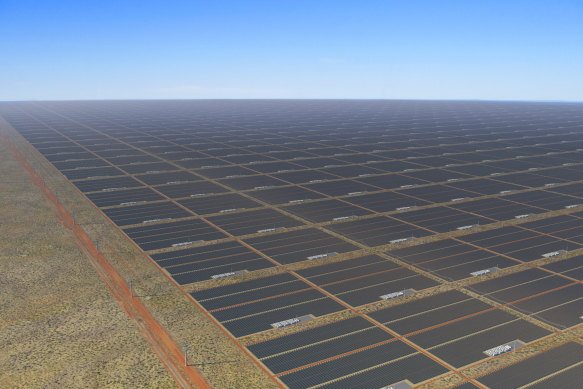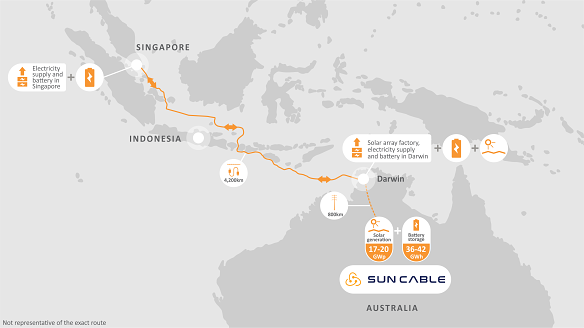Shades of Icarus and a hint of the Phoenix in Sun Cable’s collapse
There was always a whiff of singed feathers and burnt wax about the Sun Cable project.
In Greek mythology Icarus, as you know, flew from his imprisonment on wings fashioned of feathers and wax. Full of hubris he ignored his father’s advice and soared too close to the sun, melted his wings and fell to his death in the sea.

Few people in recent times can have been charged with hubris as much as Sun Cable’s chief proponents, the billionaires Mike Cannon-Brooks and Andrew Forrest.
The scope of their ambition in Sun Cable is staggering, even by their own standards.
They would amass a mountain of investor cash ($30 billion or so) and with it build an ocean of solar panels near Elliott, a patch of nothing in the Northern Territory.
They would then pump clean electrons via an overland wire 800 kilometres to Darwin, attach it to the biggest battery on earth, hook it up to the world’s longest and deepest submarine power cable – an extension cord the girth of a child, sheathed in armour to survive the elements – and run it through Indonesia to Singapore.
There was just one problem – the whole thing seems batty to some.
Undersea power cables aren’t exactly new, but should it be completed Sun Cable would be over five times longer than the longest built so far.
The battery would be about 150 times the size of the world’s first big battery, the giant built by Elon Musk in Hornsdale, South Australia, in 2017.
It would be “insanely large,” boasted Cannon-Brookes at a renewable energy conference in 2019.
Even the solar farm that fed it all would be the biggest on earth.
Sun Cable would provide 15 per cent of Singapore’s power, allowing the prime economic engine of South East Asia to accelerate its decarbonisation and free itself from dependence on a single dirty power source: gas.

It would lend substance to all that rhetoric we hear about Australia being a latent renewable energy superpower.
It would lend weight to the vision first outlined by India’s Prime Minister Narendra Modi during the first assembly of the International Solar Alliance in 2018 of One World, One Sun, One Grid, or OSOWOG. (There is always an acronym in climate and energy talk.)
This is the notion that with the right technology and infrastructure in place, nations rich in land and sunlight might cheaply shift clean electricity to those with dense populations but less space and sun.
Midday sun might be harvested in one longitude, then dispatched to others where the day is ending, shadows lengthening, and electricity demand peaking.
Which is to say cheap power could be sold at premium prices.
This would overcome the problems of intermittency and unpredictability that has plagued the development of renewables. After all, if a grid is big enough, the sun is always shining on it somewhere. Far from being unpredictable, we know what time the sun rises and sets thousands of years hence.
Given the right financial structure, someone might even turn a profit one day.
The project has always had its critics, some of whom seemed to be affronted by its chief protagonist’s claims that they could at once serve both the common good and investor interests.

The announcement this week that the project had slipped into administration due to a dispute between the two men might come as little surprise to these critics.
But not everyone believes the project is dead.
Cannon-Brookes and Forrest are still voicing their support for the project – or elements of it – if not for one-another’s role in it.
Not surprisingly the Northern Territory government – which stands to benefit as long Sun Cable can avoid the grave – is still talking it up, as is the federal government.
Then there are those points raised above.
There are many ways to export power. We can stick coal in ships, oil and gas in pipelines. We can move renewables via sea or pipeline too, in the form of ammonia or hydrogen.
As Forrest keeps telling anyone he can corner at global climate conferences, should we perfect the process of reducing iron ore or making steel in furnaces fired by clean energy in Australia, the product we load on ships will basically be clean electrons.
But cables are just better, explains energy market analyst David Leitch. They are a cheaper and more efficient way of moving electricity.
This is why Australia is spending $3 billion linking the mainland to Tasmania and its vast hydropower resources via the Marinus Link; why Britain is already powered by Norwegian green energy and will soon be burning wind and sun from Morocco.
And even it can’t be resuscitated, Leitch believes the achievements of Sun Cable to date are already considerable. Cannon-Brookes and Forrest have built a credible consortium, winning the support of three nations, of Bechtel (America’s second-largest construction company) and Macquarie Bank.
“The quality is there, the names are there,” he says. “But the cost of the project is big and it’s very ambitious.
“The key question is, can it deliver energy at the price that the Singapore government wants? If it can do that it can survive,” he says.
Then he puts it another way. Sun Cable, he points out, is no larger in scope and size than the vast new Queensland LNG plays. These are projects that demanded not free market faith and muscle, but government support through cheap finance – the sort of support that Energy Minister Chris Bowen has said Sun Cable would be eligible to apply for.
The difference is that Sun Cable, should it be resurrected, would rely on emerging technology unfurled at a scale as yet unseen.
Which brings us back to the hubris, and Icarus.
Before he leapt from the tower Icarus was not only warned not to fly too high – lest the sun melt his wings – but also not to fly too low, for fear the sea would dampen them and drag him down.
Icarus’s story warns us of the dangers of complacency as much as it does of ambition.
Most Viewed in Business
Source: Thanks smh.com